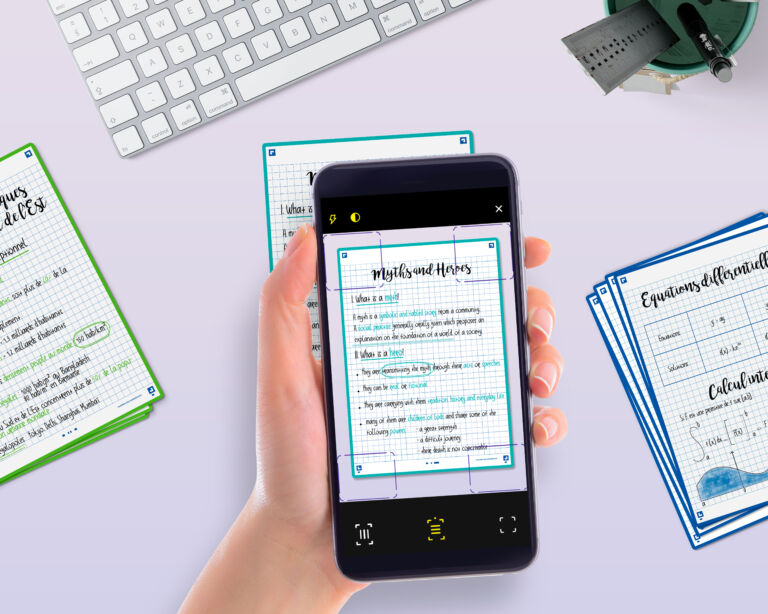
Which is the best memorisation technique: active or passive?
Our brain is a formidable ally in memorising information that’s important to us. But it’s not completely foolproof, and memorisation is a complex process. There are many memorisation techniques that can be used to remember a lesson. Depending on the method you choose, you memorise either actively or passively. But what’s the difference between these two types? Is one of these techniques more effective than the other?
How does memorising work?
Memorising is a process of acquiring and mastering information.
It involves 3 stages:
- Encoding: when you’re subjected to new information, depending on your attention and concentration, your senses will record it. This is short-term memorisation.
- Consolidation: this is the process where information is moved from the short-term to the long-term memory. The information recorded is consolidated and considered “important” by the brain, that will remember it for longer.
- Retrieval: this is the process that allows you to successfully remember the information you’ve learned.
These 3 phases are necessary for effective memorisation. But as you will have understood, several difficulties can interfere with this process: poor attention, lack of motivation and inability to remember your lessons during exams because of the illusion of learning.
So how can you get around these difficulties? What techniques should you use to boost your memory?
Active and passive memorisation: what are the differences?
As its name suggests, active memorisation is based on dynamic revision techniques that put you in action and ask you to think. Active revision methods involve effort on your part to recall stored information. Examples include asking yourself questions and answering them without looking at your notes, practising explaining your lessons to someone, etc. This works because you reuse the information you have learned by rephrasing it in your own words and unconsciously answering your own questions about your lessons.
In contrast, passive memorisation is based on methods such as reading, highlighting your notes, listening, etc… all while being passive. By using these methods, you’ll store information, but you won’t consolidate it. You’ll be able to retain it in the very short term and become familiar with the concepts of your course, but that’s all. Without more effort on your part, this information will be quickly forgotten.
Peter C. Brown, Henry L. Roediger, Mark A. McDaniel, authors of ” Make It Stick: The Science of Successful Learning “, point out that intense, passive learning just before an exam is not effective in achieving lasting mastery of knowledge. When learning requires more effort, it’s more important and lasts longer. Therefore, active revision techniques should be used in combination with frequent revision sessions at regular intervals to reactivate memory.
How to implement active revision methods?
Now that you know that you need to be active to keep your lessons fresh in your mind, you may be wondering how to put this advice into practice. Here are some specific examples of how to apply active memorisation to your revision:
- Use flashcards:
Flashcards are usually small note cards that allow you to write information in question and answer format, the question on the front and the answer on the back. Widely used in the United States, they allow you to break down your lessons into questions. The basic principle is as follows: 1 concept = 1 flashcard. Once you have made your flashcards by hand, test yourself by looking at the front and trying to find the answer without looking at the back. Then check the answer. To find out more, read our full article on using flashcards for memorising.
- Try the blank sheet method:
Also known as the blurt method, this technique helps you to memorise your lesson by following 5 simple but effective steps when combined:
- Understand: open your notes or a textbook and choose a chapter to reread. Do research to supplement your understanding of the concepts if necessary.
- Saying: rephrase your lesson orally. This will allow you to make it your own by using your own words.
- Covering: Hide your notes and take a blank sheet of paper.
- Write: On this blank sheet of paper, write down everything you remember, without trying to make it look pretty.
- Check: Compare what you have written with your lesson. Using a different coloured pen to the one you used previously, complete and correct what you have written. Repeat as many times as necessary until you have mastered your entire course.
Want to try this method? Read our full article on the Blurt method.
There are a whole host of other active techniques: mind maps, questioning among friends. It’s up to you to find the one that suits you best. And for that, there’s nothing better than trying them out. So why not have a go at blurting? A tried and tested method that’s highly viewed by many students.




